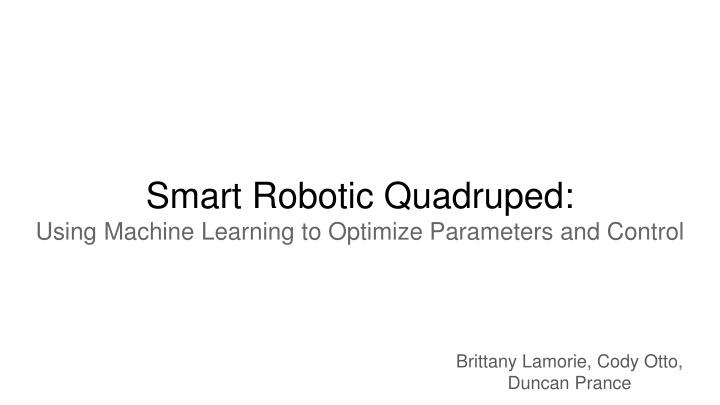
Smart Quadruped: Machine Learning for Optimized Control
Explore the innovative use of machine learning in optimizing parameters and control for a smart robotic quadruped. Discover how this project addresses hardware and software challenges, while showcasing a proof of concept and test plans. Backup plans for hardware and software are also highlighted to ensure project success in robotics development.
Download Presentation

Please find below an Image/Link to download the presentation.
The content on the website is provided AS IS for your information and personal use only. It may not be sold, licensed, or shared on other websites without obtaining consent from the author. If you encounter any issues during the download, it is possible that the publisher has removed the file from their server.
You are allowed to download the files provided on this website for personal or commercial use, subject to the condition that they are used lawfully. All files are the property of their respective owners.
The content on the website is provided AS IS for your information and personal use only. It may not be sold, licensed, or shared on other websites without obtaining consent from the author.
E N D
Presentation Transcript
Smart Robotic Quadruped: Using Machine Learning to Optimize Parameters and Control Brittany Lamorie, Cody Otto, Duncan Prance
General Information Functionality: - Taught from computer - Milestones - Adjusts on the fly Motivations: - Machine Learning - Building a robot Inspiration: - Bipedal Simulations done in 2013 Proof of Concept: https://youtu.be/M8YjvHYbZ9w?t=15
Hardware Block Diagram
Hardware Challenges: - Voltage - Power - Torque Backup Plans: - Tethered - Higher torque/cost servos
Data Flow Diagram
Software Challenges: - Need to run large amounts of simulations for learning - Making sure that our code is redundant and fault tolerant - Not killing the fragile hardware Backup Plans: - Not using machine learning - Confining movement to a set boundary - Physical tethering for power requirements
Test Plan Hardware: - Test servo motion - Test single leg - Test weight with full setup Software: - Test robot fully in simulation software (pre-recorded) - Using working robot to test simulation results for accuracy - Setup learning algorithm and test that the parameters fall inside set boundaries
